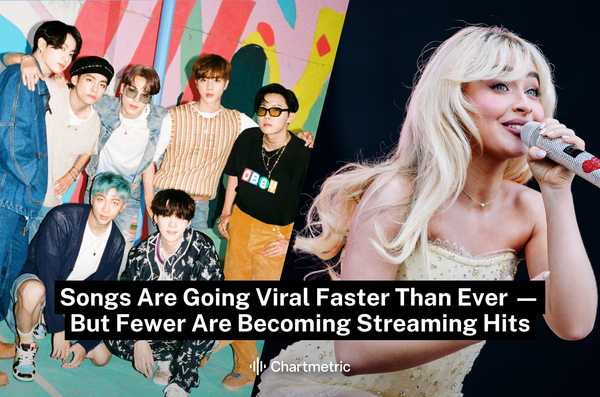In his new song "Sapphire," Ed Sheeran (CM Rank: 5) returns to India, a place that has remained part of his orbit since he first stopped by on his X tour in 2015. Both the track and the video, shot on location, is a quiet nod to that connection.
Sheeran surprises listeners by singing the chorus in Hindi and teaming up with another icon- Arijit Singh (CM Rank: 36), whose voice has defined the landscape of Indian music for decades. His voice anchors the song, shaped by a rich catalog spanning across India’s many languages. This multilingual reach offers emotional familiarity to listeners in a country where musical identity shifts every few hundred miles.
When a global artist sings in Hindi, and shares the spotlight with someone unknown in the West but central to millions elsewhere, it forces a sharper question: How does influence move today and what role does India play in that equation?
Audience vs. Engagement
With over 74 million views on Youtube and 46 million Spotify streams in under three weeks, "Sapphire" gained rapid traction –especially on Youtube, where engagement spiked sharply within the first 48 hours.
But streaming numbers alone don’t explain the entire story. On the surface, it may look like a routine global collaboration, but a closer look reveals the engine behind it: Indian fan behaviour. And no artist embodies that engine more than Arijit Singh, who, as of June 2025, is the most followed artist on Spotify, with over 150 million followers – a number that surpasses every global artist, across genres.
While Taylor Swift and Ed Sheeran dominate Western press cycles, Arijit’s lead suggests a different kind of fandom, one that is rooted in catalog depth and multilingual reach. His presence here is not new but the recognition is.
That consistency shows up on other platforms too. On YouTube, Arijit averages over 38.5M daily views, nearly double the average of other global chart toppers.
This chart shows how Arijit outpaces many globally recognised acts in daily engagement. The scale is native to India, but the depth of interactions has implications beyond language or geography.
Even on Instagram, where Ed Sheeran has a much larger following, Arijit leads in post engagement. This tells us something important: Indian fandom is deeply participatory.
Engagement, more than visibility, defines value and Arijit’s following behaves less like an audience and more like a built-in feedback loop.
What’s unfolding here is more than a successful collaboration. It marks a turning point in how global platforms need to approach India: not as an emerging market, but as an established engine of engagement.
What does this mean for India?
For a long time, India’s musical identity was projected outward through Bollywood. From Snoop Dogg to Kylie Minogue, many Western artists have lent their voices to soundtracks or appeared in cameos engineered for spectacle. However, what once served as the only gateway is now one of the many entry points.
India today is a mobile-first, streaming native market where language, region and fandom fracture traditional formulas. In this environment, artists build their fanbase through linguistic intimacy rather than crossover appeal. Arijit Singh’s pan-Indian dominance comes not from his fluency in over just one language but from legibility across multiple Indian languages —each carrying its own weight in regional identity.
On the other hand, global-facing Indian acts like Peter Cat Recording Co. offer a compelling counterpoint: they sing in English, sidestep rigid genre categories, and maintain a multilingual fanbase across India and the West. This co-existence of regional pride and global fluency defines India’s sonic advantage.
Genres that were once considered niche - Tamil lo-fi, Marathi Rap now sit at the center of music discovery. Global genres have found a new life by blending with local languages, creating distinct sonic hybrids that resonate across regions.
According to MIDiA Research, platforms like Youtube have positioned India as a streaming powerhouse, where hyperlocal content can scale without relying on traditional gatekeepers.
What once needed industry validation now rides algorithmic momentum and community behaviour.
Should Artists Collaborate with India?
For global artists, collaborations with Indian artists are no longer cultural novelties. These are strategic decisions shaped by platform dynamics, audience behaviour, and a recalibration of influence. Indian audiences already drive measurable outcomes across entertainment ecosystems.
According to Fortune India, streaming in India has grown 71% since 2021, with Nielsen now treating the country as a live lab for multilingual content innovation. This growth has rewired the fan dynamic. Streaming platforms reflect this change, as algorithms increasingly prioritise local engagement metrics alongside global benchmarks.
In this context, the success of Sapphire reflects a relationship that has been years in the making. Ed Sheeran has maintained a long standing connection with India. In 2017, he performed a sold out solo show in Mumbai, arriving on stage in a blue kurta and appearing at ease with his surroundings. Since then, India has grown into one of his key secondary markets. His creative choices on the track - singing in Hindi, filming in India , and collaborating with Arijit Singh reflects strategic cultural fluency.
So should more Western acts collaborate with Indian artists? Yes, but only if the approach accounts for the complexity of the market. That means moving beyond tokenism and embracing linguistic multiplicity and regional specificity.
India’s music ecosystem is built on three overlapping forces: hyperlocal languages, deeply rooted traditional sounds, and a fluid embrace of global genres. This creates a uniquely malleable soundscape - where Tamil lo-fi, Punjabi trap, and emerging rappers spitting 15+ languages are the norm.
India today, is the ultimate litmus test for what’s next in global music. Not just because of scale, but because of how fandom behaves -with intensity, multilingual fluency, and visceral loyalty. It’s where algorithms bend to emotion, and where the next big track isn’t just streamed - it is driven to the top of the charts by sheer fan force.






